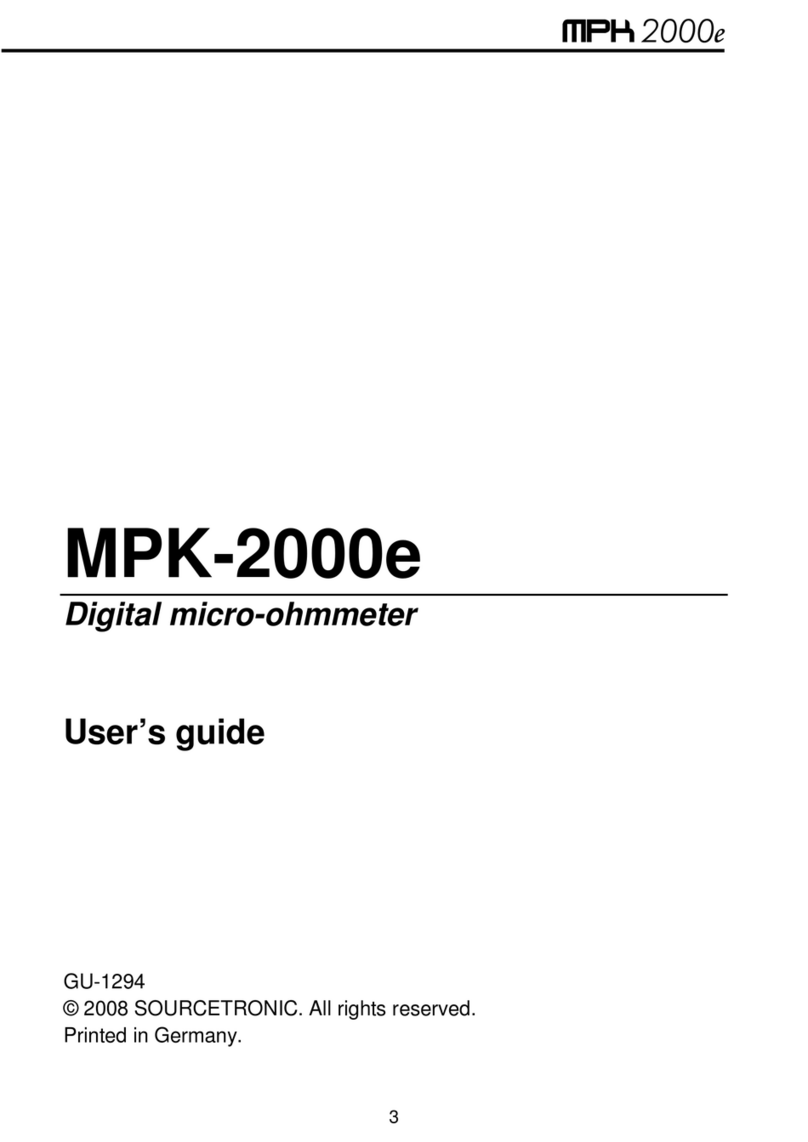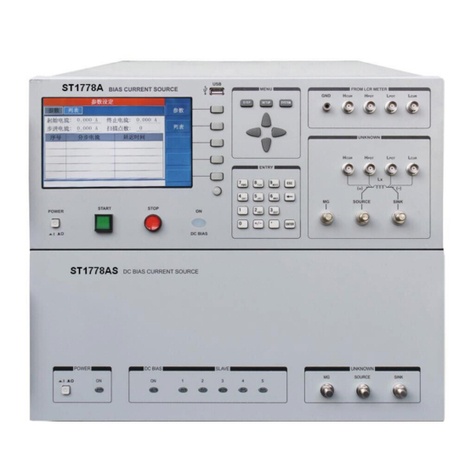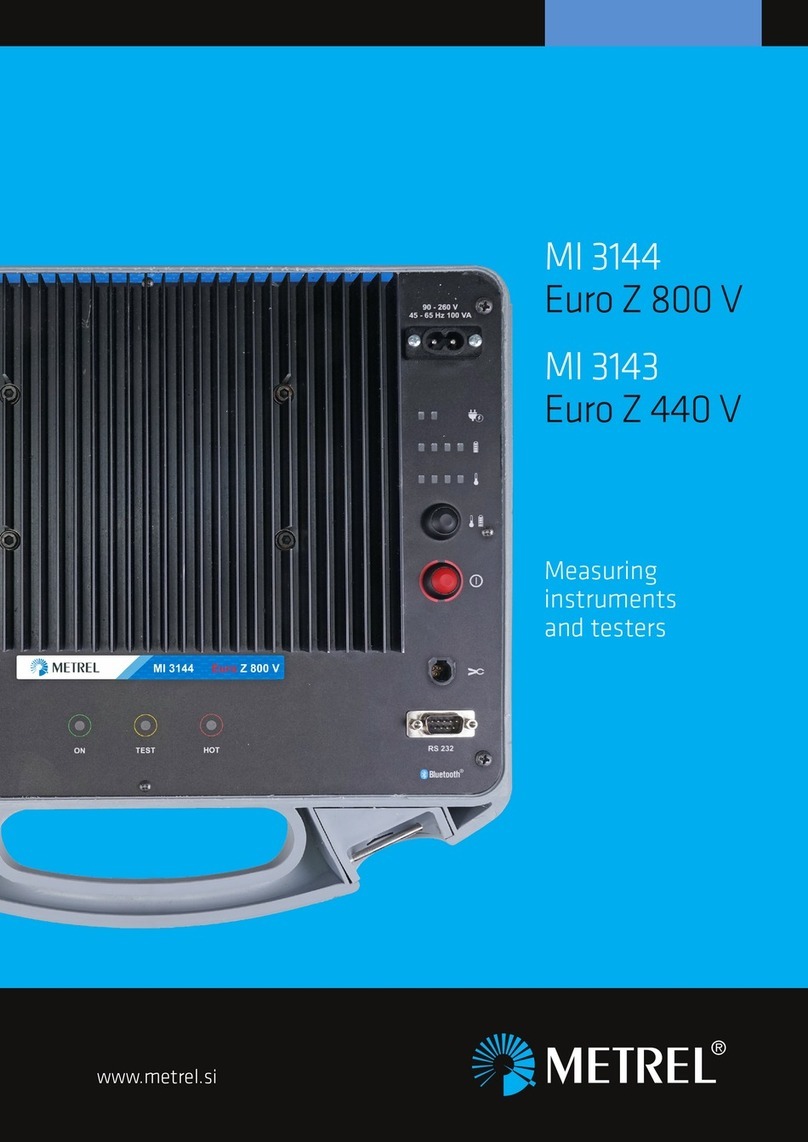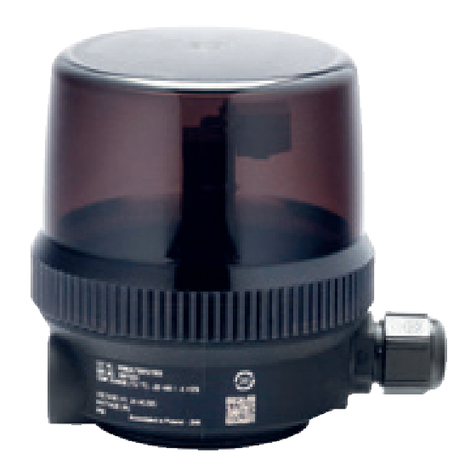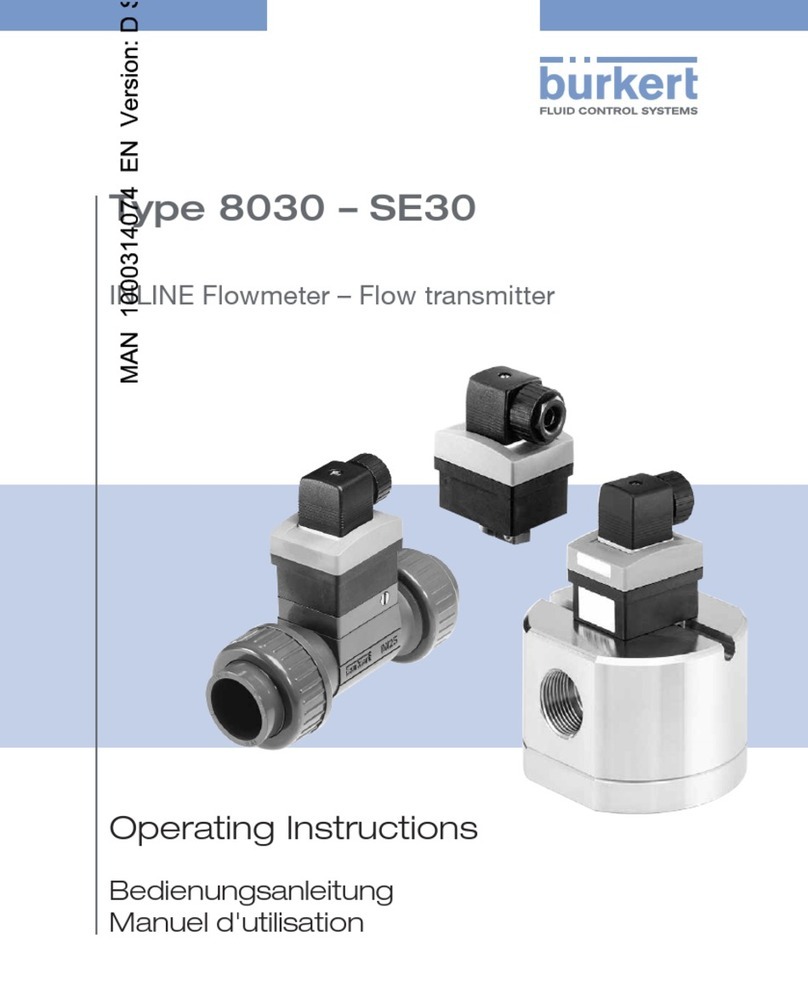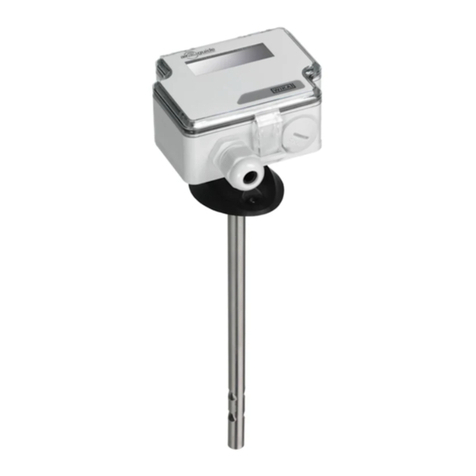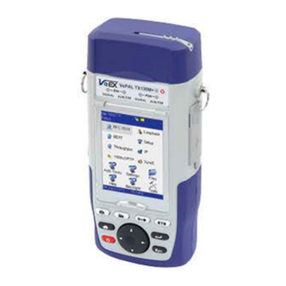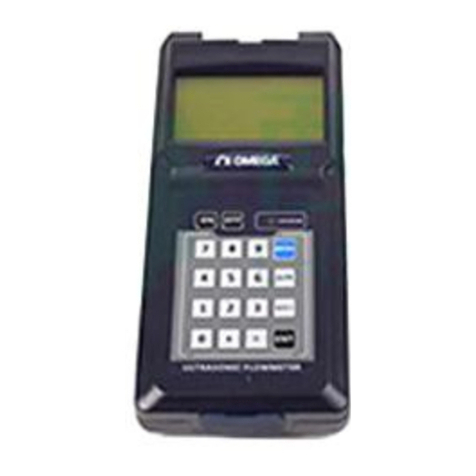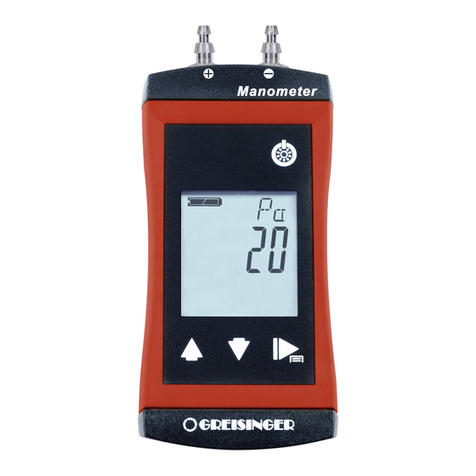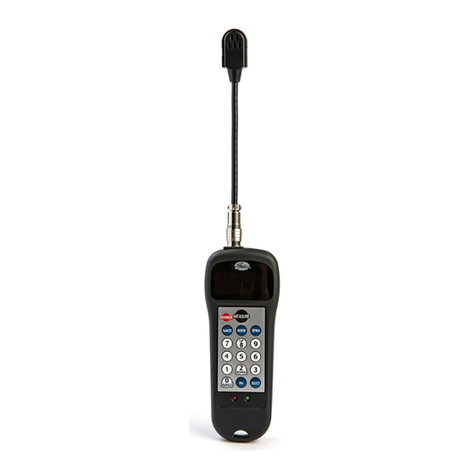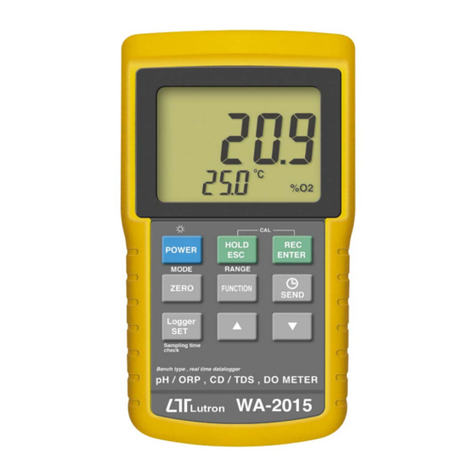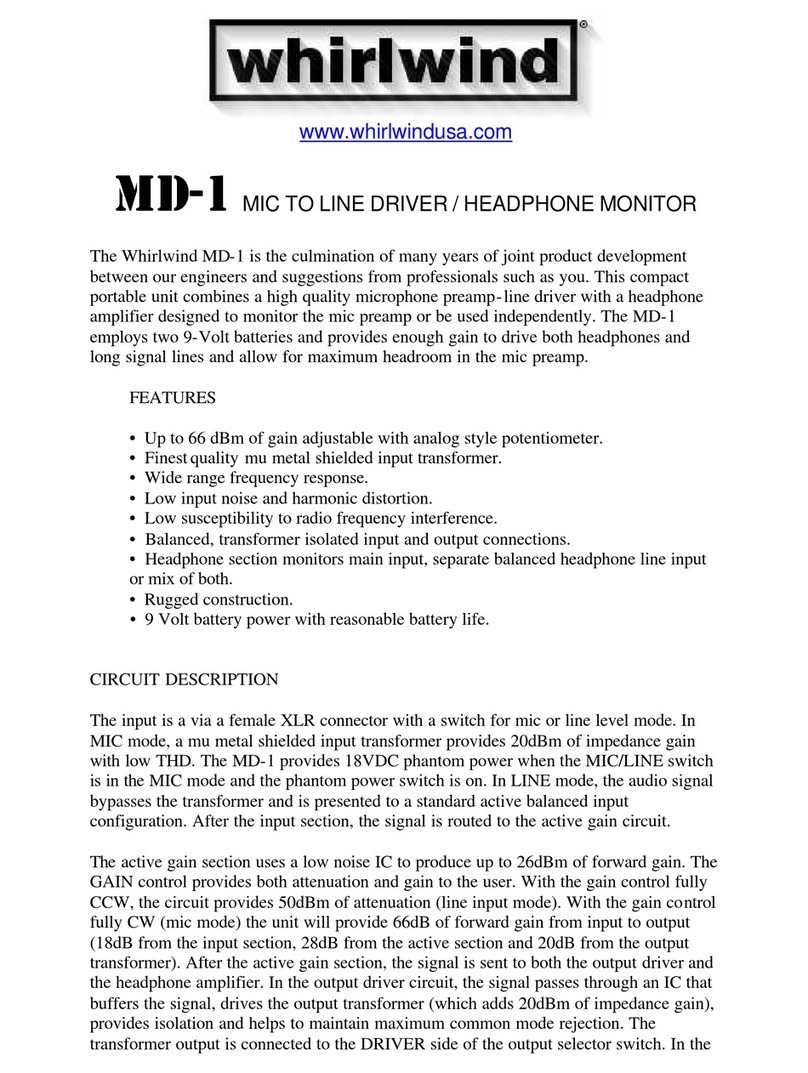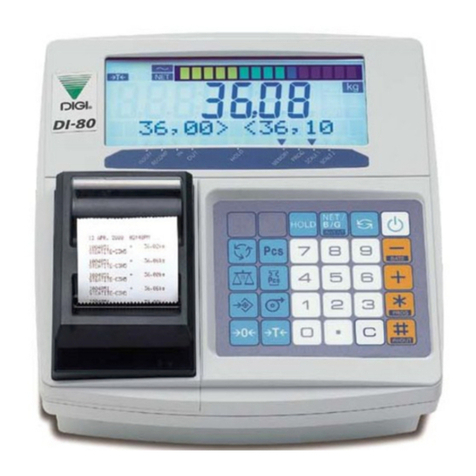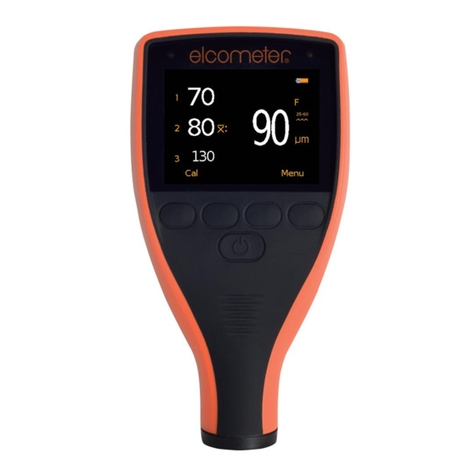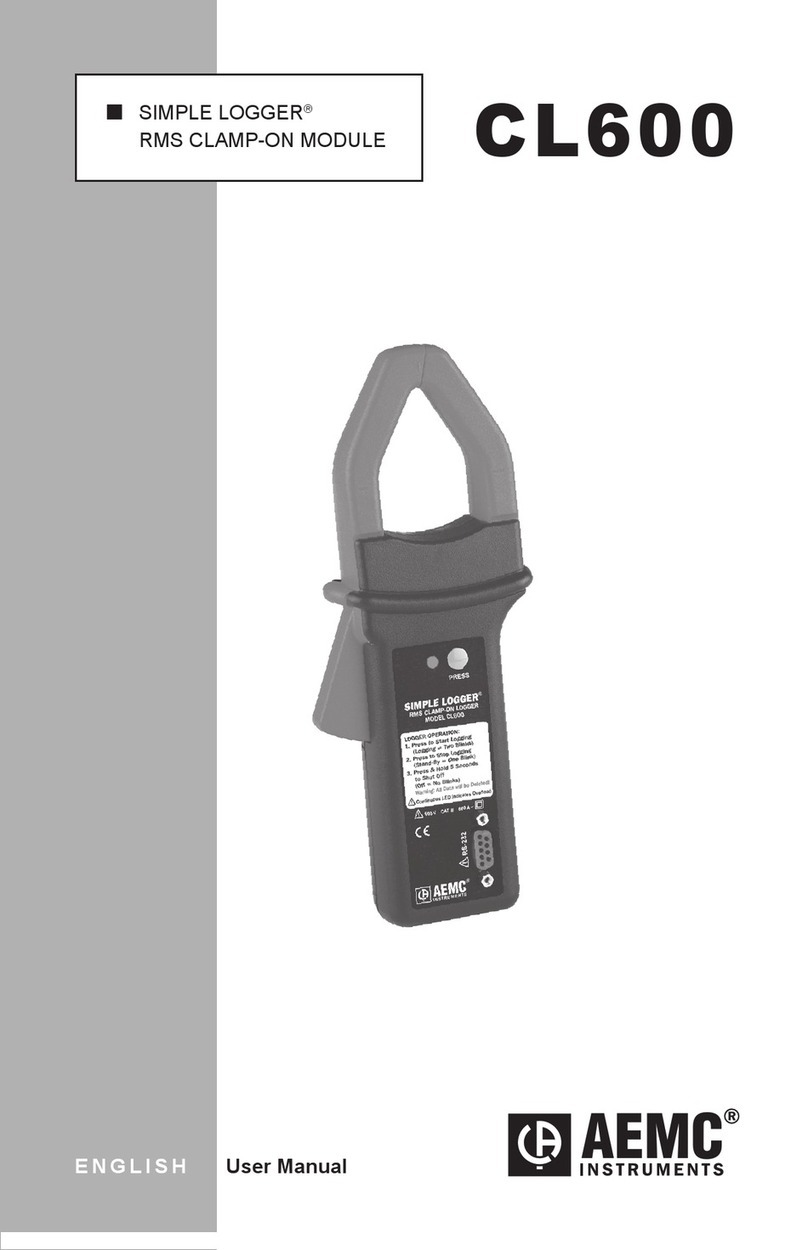Sourcetronic ST2829A User manual

SOURCETRONIC −Qualitäts-Elektronik für Service, Labor und Produktion
LCR meter ST2829A/B/C
Manual

ST2829 Series Operation Manual Contents
I
Contents
Chapter 1 Out of Box Audit...........................................................................................................1
1.1 To Inspect the package.................................................................................................1
1.2 Power connection ........................................................................................................1
1.3 Fuse ..............................................................................................................................1
1.4 Environment.................................................................................................................2
1.5 Use of Test Fixture........................................................................................................2
1.6 Warm-up ......................................................................................................................2
1.7 Other features ..............................................................................................................2
Chapter 2 Introduction .................................................................................................................4
2.1 Introduction to front panel ..........................................................................................4
2.2 Introduction to rear panel............................................................................................6
2.3 Introduction to display zone.........................................................................................7
2.4 Main menu keys and corresponding displayed pages..................................................8
2.4.1 [DISP]....................................................................................................................8
2.4.2 [SETUP].................................................................................................................8
2.4.3 [SYSTEM] ..............................................................................................................8
2.5 Basic Operation ............................................................................................................9
2.6 Start the instrument.....................................................................................................9
Chapter 3 Introduction to [DISP].................................................................................................11
3.1 <MEAS DISPLAY> ........................................................................................................11
3.1.1 Test function.......................................................................................................12
3.1.2 Test range ...........................................................................................................14
3.1.3 Test frequency ....................................................................................................14
3.1.4 Test level.............................................................................................................15
3.1.5 DC bias................................................................................................................16
3.1.6 Test speed...........................................................................................................16
3.1.7 Tools ...................................................................................................................17
3.1.8 Save LCR test result by U disk.............................................................................18
3.2 <BIN NO. DISP>...........................................................................................................18
3.2.1 Comparator function..........................................................................................19
3.3 <BIN COUNT DISP> .....................................................................................................20
3.3.1 PARAM................................................................................................................21
3.3.2 NOM. ..................................................................................................................21
3.3.3 BIN......................................................................................................................21
3.3.4 HIGH/LOW..........................................................................................................21
3.3.5 COUNT................................................................................................................21
3.3.6 AUX.....................................................................................................................21
3.3.7 OUT ....................................................................................................................21
3.4 <LIST SWEEP DISP>.....................................................................................................22
3.4.1 Sweep mode.......................................................................................................23
3.4.2 FREQ (Hz)............................................................................................................23
3.4.3 Cp[F] D[ ] ............................................................................................................23

ST2829 Series Operation Manual Contents
II
3.4.4 CMP (Compare) ..................................................................................................23
3.5 <TRACE SWEEP>page .................................................................................................24
3.5.1 FORMAT..............................................................................................................24
3.5.2 SCALE..................................................................................................................25
3.5.3 READ...................................................................................................................25
3.5.4 TRACE .................................................................................................................25
3.5.5 POINTS................................................................................................................25
3.5.6 TRIGGER .............................................................................................................25
3.6 <MEASURE SETUP> ....................................................................................................26
3.6.1 Trigger mode ......................................................................................................28
3.6.2 Auto level control function.................................................................................28
3.6.3 Bias current isolation function ...........................................................................29
3.6.4 Average...............................................................................................................30
3.6.5 Level monitor function.......................................................................................30
3.6.6 Delay time ..........................................................................................................31
3.6.7 Output impedance .............................................................................................31
3.6.8 Deviation test function.......................................................................................31
3.7 <CORRECTION> ..........................................................................................................33
3.7.1 OPEN ..................................................................................................................34
3.7.2 SHORT.................................................................................................................35
3.7.3 LOAD...................................................................................................................36
3.7.4 Load correction test function .............................................................................38
3.7.5 Cable length selection ........................................................................................38
3.7.6 Single/ multi correction mode ...........................................................................38
3.8 <LIMIT TABLE>............................................................................................................39
3.8.1 Swap parameter .................................................................................................39
3.8.2 Limit modes of compare function ......................................................................40
3.8.3 Set nominal value of tolerance mode ................................................................41
3.8.4 Comparator function ON/OFF............................................................................41
3.8.5 Auxiliary bin ON/OFF..........................................................................................42
3.8.6 HIGH/LOW..........................................................................................................43
3.9 <LIST SWEEP SETUP>..................................................................................................44
3.9.1 MODE .................................................................................................................44
3.9.2 Test parameter ...................................................................................................44
3.9.3 Sweep parameter setup .....................................................................................45
3.10 <TRACE SWEEP SETUP>..............................................................................................45
3.10.1 MODE .................................................................................................................46
3.10.2 START ..................................................................................................................47
3.10.3 END.....................................................................................................................47
3.10.4 Coordination range setting.................................................................................47
Chapter 4 [SYSTEM] and <FILE MANAGE> ..................................................................................48
4.1 <SYSTEM SETUP>........................................................................................................48
4.1.1 MAIN FUNC ........................................................................................................48
4.1.2 ON BEEPERS........................................................................................................48

ST2829 Series Operation Manual Contents
III
4.1.3 PASS BEEP...........................................................................................................49
4.1.4 FAIL BEEP............................................................................................................49
4.1.5 LANGUAGE .........................................................................................................50
4.1.6 PASS WORD ........................................................................................................50
4.1.7 BUS MODE (Reserved function) .........................................................................51
4.1.8 GPIB ADDR (Reserved function) .........................................................................51
4.1.9 TALK ONLY...........................................................................................................51
4.1.10 BIAS SRC .............................................................................................................51
4.1.11 BAUD RATE .........................................................................................................52
4.1.12 DATA/TIME .........................................................................................................52
4.2 LCR <FILE MANAGE> ..................................................................................................53
4.2.1 Setup file for single-group component (*.STA) ..................................................53
4.2.2 U-disk manage performance..............................................................................54
4.2.3 Operation steps for file management ................................................................54
Chapter 5 Execute LCR operation and some examples...............................................................57
5.1 Correction operation..................................................................................................57
5.1.1 Sweep correction................................................................................................57
5.1.2 Point-frequency correction ................................................................................58
5.2 Correct connection of DUT.........................................................................................58
5.3 Eliminate the influence of stray impedance...............................................................59
5.4 Operation example for testing inductance with ST2829A..........................................60
5.5 Operation example of testing capacitance by multi-frequency list sweep
………………………………………………………………………………………………………… ………………….62
5.6 Operation example of load correction .......................................................................65
Chapter 6 Performance and Test ................................................................................................67
6.1 Test function...............................................................................................................67
6.1.1 Parameter and symbol .......................................................................................67
6.1.2 Mathematical operation.....................................................................................67
6.1.3 Equivalent mode ................................................................................................67
6.1.4 Range..................................................................................................................67
6.1.5 Trigger.................................................................................................................67
6.1.6 Delay time ..........................................................................................................68
6.1.7 Connection modes of test terminals ..................................................................68
6.1.8 Test speed (Frequency>=10kHz).........................................................................68
6.1.9 Average...............................................................................................................68
6.1.10 Display digit ........................................................................................................68
6.2 Test signal ...................................................................................................................68
6.2.1 Test signal frequency..........................................................................................68
6.2.2 Signal mode........................................................................................................69
6.2.3 Test signal level...................................................................................................69
6.2.4 Output impedance .............................................................................................69
6.2.5 Monitor for test signal level ...............................................................................69
6.2.6 Maximum measurement display range..............................................................69
6.2.7 DC bias voltage source .......................................................................................70

ST2829 Series Operation Manual Contents
IV
6.3 Measurement accuracy..............................................................................................70
6.3.1 Accuracies of │Z│,│Y│, L, C, R, X, G, B.................................................................70
6.3.2 Accuracy of D......................................................................................................70
6.3.3 Accuracy of Q .....................................................................................................71
6.3.4 Accuracy of θ......................................................................................................71
6.3.5 Accuracy of G......................................................................................................71
6.3.6 Accuracy of Rp....................................................................................................71
6.3.7 The accuracy of Rs..............................................................................................72
6.3.8 Accuracy factor...................................................................................................72
6.3.9 Accuracy of DCR .................................................................................................75
6.3.10 Accuracy of leakage inductance Lk.....................................................................75
6.4 Safety requirement ....................................................................................................75
6.4.1 Insulation resistance...........................................................................................76
6.4.2 Insulation intensity .............................................................................................76
6.4.3 Leakage current..................................................................................................76
6.5 Electromagnetic compatibility ...................................................................................76
6.6 Performance test........................................................................................................76
6.6.1 Working condition..............................................................................................76
6.6.2 The used instruments and devices.....................................................................76
6.6.3 Function check ...................................................................................................77
6.6.4 Test signal level...................................................................................................77
6.6.5 Frequency...........................................................................................................77
6.6.6 Measurement accuracy......................................................................................78
6.6.7 Accuracy of C and D............................................................................................78
6.6.8 Accuracy of L ......................................................................................................78
6.6.9 Accuracy of Z ......................................................................................................78
6.6.10 Accuracy of DCR .................................................................................................79
Chapter 7 Command Reference..................................................................................................80
7.1 Subsystem commands for ST2829..............................................................................80
7.1.1 DISPlay subsystem commands ...........................................................................80
7.1.2 FREQuency subsystem commands .....................................................................82
7.1.3 VOLTage subsystem commands..........................................................................83
7.1.4 CURRent subsystem commands.........................................................................83
7.1.5 AMPLitude subsystem commands .....................................................................84
7.1.6 Output RESister subsystem commands..............................................................84
7.1.7 OUTPut subsystem commands...........................................................................84
7.1.8 BIAS subsystem commands................................................................................86
7.1.9 FUNCtion subsystem commands........................................................................87
7.1.10 LIST subsystem commands.................................................................................91
7.1.11 APERture subsystem commands ........................................................................94
7.1.12 TRIGger subsystem commands ..........................................................................95
7.1.13 FETCh? subsystem commands ...........................................................................96
7.1.14 CORRection subsystem commands ....................................................................98
7.1.15 COMParator subsystem commands .................................................................104

ST2829 Series Operation Manual Contents
V
7.1.16 Mass MEMory subsystem commands..............................................................109
7.2 GPIB Common Commands .......................................................................................110
Announcement
The description of the manual may not cover all contents of the instrument, and
our company is subject to change and to improve the performance, function,
inner structure, appearance, accessory and package of the instrument without
notice. If there is puzzle caused by inconsistency of manual and instrument, then
you can contact with our company by the address on the cover.

ST2829 Series Operation Manual Chapter 1 Out of Box Audit
1
Chapter 1 Out of Box Audit
When you receive the instrument, some inspections are necessary, and the
condition must be understood and available before installing the instrument.
1.1 To Inspect the package
Inspect the shipping container for damage after unpacking it. It is not
recommended to power on the instrument in the case of a damaged container.
If the contents in the container do not conform to the packing list, notify us or
your dealer.
1.2 Power connection
1) Power-supplying voltage range: 100~120Vac or 198~242Vac. Being related
with the power setup on the rear panel.
2) Power-supplying frequency range: 47~63Hz.
3) Power-supplying power range: less than 80VA.
4) Power supplying input phase line L, zero line N, ground lead E should be as
same as the power plug of the instrument.
5) After careful design, the instrument can reduce the clutter jamming caused
by AC power terminal input, however, it should be used under the
environment with low-noise. Please install power filter if being unavoidable.
———————————————————————————————————————
Warning: In order to prevent user and instrument from being hurt by
leakage, it is necessary for user to guarantee the ground line of supply
power being reliably grounded.
———————————————————————————————————————
1.3 Fuse
The instrument has installed fuse, so operators should use the installed fuse of
our company.
———————————————————————————————————————
Warning: Be sure that the location of fuse is consistent with
power-supplying voltage range before charging.
———————————————————————————————————————

ST2829 Series Operation Manual Chapter 1 Out of Box Audit
2
1.4 Environment
1) Please do not operate the instrument in the place that is vibrative, dusty,
under direct sunlight or where there is corrosive air.
2) The normal working temperature is 0℃~40℃, relative humidity ≤75%, so the
instrument should be used under above condition to guarantee the accuracy.
3) There is heat abstractor on the rear panel to avoid the inner temperature
rising. In order to keep good airiness, please don’t obstruct the left and right
airiness holes to make the instrument maintain the accuracy.
4) Although the instrument has been specially designed for reducing the noise
caused by ac power, a place with low noise is still recommended. If this
cannot be arranged, please make sure to use power filter for the instrument.
5) Please store the instrument in the place where temperature is between 5℃
and 40℃, humidity is less than 85%RH. If the instrument will not be put in use
for a time, please have it properly packed with its original box or a similar box
for storing.
6) The instrument, especially the test cable should be far from strong
electro-magnetic field, to avoid the jamming on measurement.
1.5 Use of Test Fixture
Please use the accessory test fixture or cable, the test fixture made by user or
from other company may cause the incorrect measurement result. The
test fixture or cable should be kept clean, as well as the pin of DUT, thus to
guarantee the good connection between DUT and fixture.
Connect the fixture or cable to four test terminals Hcur, Hpot, Lcur, Lpot on the
front panel. As for the DUT with shielding shell, connect shielding layer or ground
“┴”.
Note: When test fixture or cable has not being installed, the instrument will
display an unstable test result.
1.6 Warm-up
1) To guarantee the accurate measurement, the warm-up time is no less than
15min.
2) Please not turn on or off instrument frequently, in order to avoid the inner
data fluster.
1.7 Other features
1) Power: consumption power≤80VA.

ST2829 Series Operation Manual Chapter 1 Out of Box Audit
3
2) Dimension (W*H*D): 430mm*185mm*473mm
3) Weight: About 13kg.

ST2829 Series Operation Manual Chapter 2 Introduction
4
Chapter 2 Introduction
In this chapter, the basic operation features of ST2829 series are described.
Please read the content carefully before using ST2829 series instruments, thus
you can learn the operation of ST2829.
ST2829 series instrument includes ST2829A, ST2829B and ST2829C. There
frequency ranges are respectively 20Hz-300KHz, 20Hz-500KHz and 20Hz-1MHz.
This manual takes ST2829A for example to describe the basic operation of
6T2829 series.
2.1 Introduction to front panel
Figure 2-1 shows the front panel of ST2829.
1) USB HOST interface
Connect U flash disk so as to save or use a specified file.
2) [KEYLOCK]
Press [KEYLOCK], it will be lighted, which means the function of current panel
is locked. Press it again, it will be off, which means discharging the lock status.
If the password function is ON, it means correct password is necessary when
discharging the key-lock, or the key cannot be unlocked.
3) [DC BIAS]
[DC BIAS] is used to permit or forbid the output of 0-100mA/10V DC bias
source. Press this key, it will be lighted which means DC bias output is
permitted. Press this key once more, it will be off which means DC bias output
is prohibited. The key is useless in some pages where the DC BIAS cannot be
added.
4) [DC SOURCE]
This key is used to permit or forbid the output of a 10V individual voltage
source.
5) Brand and model
Brand and model
DC BIAS
KEYLOCK
DC SOURCE
DISP SETUP
SYSTEM
7 8 9
ESC
654
1 2 3
0+/ -
ENTER
RESET
PASS
FAIL
TRIGGER
CAL
PQRS TUV WXYZ
GHI JKL MNO
ABC DEF
ST2829A
PRECISION LCR METER
-Hz20 Hz300 k
MENU OPERATION
DC SOURCE
L
CUR
L
POT
H
POT
H
CUR
±42 Max
!
VDC
UNKNOWN
CAT
Ⅰ
ENTRY
COPY
RETURN
POWER
1 2 3 4 5 6 7 8 9 10 11 12 13 15
161718212223242526
14
1927 20

ST2829 Series Operation Manual Chapter 2 Introduction
5
6) LCD
800*480 colorful TFT LCD displays measurement results and conditions.
7) [COPY]
Copy the currently displayed page to USB memory.
8) [DISP]
Press this key to enter into the corresponding measurement display page of
instrument functions.
9) [SETUP]
Press this key to enter into the corresponding measurement setup page of
instrument functions.
10) [SYSTEM]
Press this key to enter into the system setup page.
11) Numerical keys
These keys are used to input data to the instrument. The key consists of
numerical keys [0] to [9], decimal point [.] and [+/-] key.
12) [ESC]
ESCAPE key
13) [←]
BACKSPACE key is used delete the last numeric of the input value.
14) [CAL]
Execute the calibration operation. Press this key to execute OPEN/SHORT
calibration.
15) PASS indicator
LED indicator shows the test result has passed.
16) [TRIGGER]
When the trigger mode is set to MAN mode, press this key to trigger the
instrument.
17) [RESET]
Press this key, other operation cannot be executed on other pages.
18) FAIL indicator
LED indicator shows the test result has failed.
19) [ENTER]
This key is used to end the input of data, and confirm and save the data
displayed on the inputting line (the bottom line on LCD).
20) Test terminals (UNKNOWN)
4-teminal test pair is used to connect 4-terminal test fixture or cable to
measure DUT.
The 4 terminals are respectively as follows: Hcur, Hpot, Lpot and Lcur.
DCI BIAS terminal
21) CURSOR
This key is used to move the cursor on the LCD displayed page. When the
cursor moves to a zone, the corresponding zone will be lightened.

ST2829 Series Operation Manual Chapter 2 Introduction
6
22) Knob for menu selection and numeric input
This knob is used to move the cursor, select and set parameters.
23) Confirmation key
This key is used to end the data input, confirm and save the data input
through knob.
24) Ground terminal
The ground terminal is connected with the case of instrument, which can be
used to protect or shield the ground connection.
25) File
Press this key to enter into the file manage system.
26) Soft keys
Six soft keys are used to select parameters. The corresponding function of
each soft key has been displayed on its left (the right part of LCD). The
function definition varies with different pages.
27) POWER
Power switch
2.2 Introduction to rear panel
Figure 2-2 shows the rear panel of ST2829.
Figure 2-2 Rear panel
1) HANDLER interface
Handler interface is used to realize the sorting output of test results.
2) LAN interface
LAN interface is used to realize the control and the communication of network
system.
3) Nameplate
Information about production date, instrument number and manufacturer
etc..
4) USB DEVICE interface
The tester can communicate with PC through the USB DEVICE interface.
5) SCANNER interface
RATING FUSE
110V/60Hz 80VA
220V/50Hz 80VA T2AL 250V
~
~
T4AL 250V
!
TO AVOID ELECTRIC SHOCK,
THE POWER CORD PROTECTIVE GROUNDING CONDUCTOR
MUST BE CONNECTED TO GROUND.
DISCONNECT POWER SUPPLY BEFORE REPLACING FUSE.
WARNING
RS-232C
LAN DEVICE
SCANNER
HANDLER
DC BIAS INTERFACE
IEEE-488
1 2 3 4 5 6 7 8 9 10 11

ST2829 Series Operation Manual Chapter 2 Introduction
7
6) IEEE-488 interface
The tester can communicate with PC through GPIB interface.
7) RS232 interface
Series communication interface can realize the communication with PC.
8) Fan window
Heat elimination, maintaining the normal working temperature
9) Power socket
Input AC power.
10) Fuse base
Being used to install power fuse, protect instrument, and switch 110V/220V
by changing the direction of core.
———————————————————————————————————————
Warning: Be sure that the direction of fuse is accordant with
power-supply voltage range before charging.
———————————————————————————————————————
11) Ground terminal
The ground terminal is connected with instrument casing, being available for
protecting or shielding ground connection.
2.3 Introduction to display zone
ST2829 applies a 65k, 7-inch TFT display. The display screen is divided into the
following zones:
1
4 3 2
Figure 2-3 display zones

ST2829 Series Operation Manual Chapter 2 Introduction
8
1) Display page name
Indicate the name of the currently displayed page.
2) Soft keys
The zone is used to display the function definition of soft key. The definition of
soft key can be different as the difference of cursor’s direction in the zone.
3) Test result/ condition display zone
In this zone, test result information and current condition are displayed.
4) Help
In this zone, information about system and user data input is displayed.
2.4 Main menu keys and corresponding displayed
pages
2.4.1 [DISP]
When the LCR function is active, press this key-[DISP] to enter into the LCR
measurement display page, the following soft keys will be displayed in the soft
key zone.
<MEAS DISPLAY>
<BIN NO.>
<BIN COUNT>
<LIST SWEEP DISP>
<TRACE SWEEP DISP>
<SAVE LOG>
2.4.2 [SETUP]
When the LCR function is active, press this key-[SETUP], the following soft keys
will be displayed in the soft key zone on the LCR measurement setup page.
<MEAS SETUP>
<CORRECTION>
<LIMIT TABLE>
<LIST SWEEP SETUP>
<TRACE SWEEP SETUP>
<TOOL>
2.4.3 [SYSTEM]
This key-[SYSTEM] is used to enter into the system setup page. The following
soft keys will be available:

ST2829 Series Operation Manual Chapter 2 Introduction
9
<SYSTEM SETUP>
<LAN SETUP>
2.5 Basic Operation
Basic operation of ST2829 is as follows:
Use menu keys ([DISP], SETUP], [SYSTEM]) and soft keys to select the
desired page.
Use cursor keys ([←][→]) and the slide switch to move the cursor to the
desired zone. When the cursor moves to a specified zone, the zone will
become reverse expression.
The soft key functions corresponding to the current zone of the cursor will be
displayed in the soft key zone. Users can select and use the desired key.
Numeric keys, [BACKSPACE] and [ENTER] are used to input data.
When a numeric key is pressed down, the usable unit soft key will be
displayed in the soft key zone. You can choose a unit soft key or press [ENTER]
to end data inputting. When [ENTER] is used to terminate data inputting, the
unit of data will be set to a default unit, such as Hz, V or A. For example, the
default unit for frequency is Hz.
2.6 Start the instrument
Plug in 3-line power plug.
Caution: Keep the power-supply voltage and frequency conform to above
specifications. Power input phase line L, zero line N, ground line E should be the
same as that of the instrument.
Press the power switch at the left corner on the front panel and then a boot screen
will appear which displays our company logo, instrument model (ST2829A), and
the version number of the software (Ver1.0.0).

ST2829 Series Operation Manual Chapter 2 Introduction
10
If the password protection function is on, users are required to input the
password and then press [ENTER] to enter into the page of main menu.
———————————————————————————————————————
Note: The instrument has a default password-2829. In your practical use, you
can change it and set your own one. Please see <SYSTEM> section for more
information.

ST2829 Series Operation Manual Chapter 3 Introduction to [DISP]
11
Chapter 3 Introduction to [DISP]
3.1 <MEAS DISPLAY>
When the LCR function is applied, press [DISP], the <MEAS DISPLAY> page will
be displayed on screen as shown in the following figure.
ST2829-301
On this page, the test result is displayed in upper-case character. The
measurement control parameters can be set in this page:
Test function (FUNCA)
Test function (FUNCB)
Test frequency (FREQ)
Test level (LEVEL)
Test range (RANGE)
Test speed (SPEED)
DC bias
DC voltage source (DC SRC)
There are 8 zones in this page: FUNCA, FUNCB, FREQ, LEVEL, RANG, SPEED, DC
BIAS, DC SRC. The details will be discussed later.
The test result/ condition display zone shows the information about test condition.
These conditions can be set on <Measure> page or <Correction> page.
Signal source voltage/ current monitor (Vm, Im)
Open, short, load correction ON/OFF status (CORR)

ST2829 Series Operation Manual Chapter 3 Introduction to [DISP]
12
3.1.1 Test function
In a measurement period, ST2829 can test four parameters for an impedance
component: two primary parameters and two secondary parameters. Parameters
that can be tested are as follows:
Primary parameters
|Z| (Module of impedance)
|Y| (Module of admittance)
L (Inductance)
C (Capacitance)
R (Resistance)
G (Conductance)
DCR (DC resistance)
Secondary Parameters
D (Dissipation factor)
Q (Quality factor)
Rs (Equivalent Series Resistance ESR)
Rp (Equivalent Parallel Resistance)
X (Reactance)
B (Admittance)
θ (Phase Angle)
Test results of primary and secondary parameters are respectively displayed in
two lines in the form of upper-case characters. The primary parameter displays in
the upper line while the secondary parameter displays in the lower line.
Operation steps for setting test function:
1) Move the cursor to FUNCA zone, the following soft keys will be displayed on
the screen.
Cp—…→
Cs—…→
Lp—…→
Ls—…→
Z—…→
↓
2) Press the soft key corresponding to Cp—…→, the following parameters will be
shown for your choice.
Cp-D
Cp-Q
Cp-G
Cp-Rp
←
Press the soft key corresponding to your desired parameter. Then press ←to
return to upper soft key menu.
3) Press Cs—…→, the following parameters will be shown for your choice.
Cs-D

ST2829 Series Operation Manual Chapter 3 Introduction to [DISP]
13
Cs-Q
Cs-Rs
←
Press the soft key corresponding to your desired parameter. Then press ←to
return to upper soft key menu.
4) Press Lp—…→, the following parameters will be shown for your choice.
Lp-D
Lp-Q
Lp-G
Lp-Rp
←
Press the soft key corresponding to your desired parameter. Then press ←to
return to upper soft key menu.
5) Press Ls—…→, the following parameters will be shown for your choice.
Ls-D
Ls-Q
Ls-Rs
←
Press the soft key corresponding to your desired parameter. Then press ←to
return to upper soft key menu.
6) Press Z—…→, the following parameters will be shown for your choice.
Z-d
Z-r
←
Press the soft key corresponding to your desired parameter. Then press ←to
return to upper soft key menu.
7) Press ↓, another group of soft keys will be shown.
Y—…→
R—…→
G—B
DCR
←
Press the soft key corresponding to your desired parameter. Then press ←to
return to upper soft key menu.
8) Press Y—…→, the following parameters will be shown for your choice.
Y-d
Y-r
←
Press the soft key corresponding to your desired parameter. Then press ←to
return to upper soft key menu.
9) Press R—…→, the following parameters will be shown for your choice.
R-X
Rp-Q
Rs-Q

ST2829 Series Operation Manual Chapter 3 Introduction to [DISP]
14
←
Press the soft key corresponding to your desired parameter. Then press ←to
return to upper soft key menu.
Parameter setup of FUNCB is the same as that of FUNCA, but FUNCB can
be turned off (OFF).
3.1.2 Test range
Measurement range should be selected in accordance with the impedance value
of the tested LCR component.
ST2829 has 11 AC measurement ranges: 10Ω, 30Ω, 100Ω, 300Ω, 1kΩ, 3kΩ,
10kΩ, 30kΩ, 100kΩ, 300kΩ, 1MΩ.
ST2829 has 14 DCR measurement ranges: 30mΩ, 100mΩ, 300mΩ, 1Ω, 10Ω,
100Ω, 300Ω, 1kΩ, 3kΩ, 10kΩ, 30kΩ, 100kΩ, 300kΩ, 1MΩ.
Operation steps for setting test range:
1) Move the cursor to the range zone, the following soft keys will be displayed:
AUTO The soft key is used to set the range mode to AUTO.
HOLD The soft key is used to switch the AUTO mode to the HOLD mode.
When the range mode is set to HOLD, the range will be locked in the
current measurement range. The current measurement range will be
displayed in the range zone.
↑(+) The soft key is used to increase the range under HOLD mode.
↓(-) The soft key is used to decrease the range under HOLD mode.
2) Use soft keys to set measurement range.
3.1.3 Test frequency
The measurement range of ST2829 ranges from 20Hz to 1MHz with an increase
or decrease of 0.01Hz. When the test function is set as DCR, the FREQ zone will
display “---”.
Operation steps for setting test frequency:
ST2829A provides two methods to set measurement frequency. The first one is to
use soft keys and the other one is to input data by using numeric keys.
1) Move the cursor to the FREQ zone, the following soft keys will be displayed.
↑(++)
This is a coarse adjustment soft key used to increase the frequency. Press
this key, the frequency will change as the following sequence: 20Hz,
100Hz, 1kHz, 10kHz, 100kHz, 200kHz and 300kHz.
↑(+)
This is a fine adjustment soft key used to increase the frequency. There
are 10 frequency points that can be set among the 10 times frequency
points. Press this key, the frequency will switch between the following
ones:
This manual suits for next models
2
Table of contents
Other Sourcetronic Measuring Instrument manuals
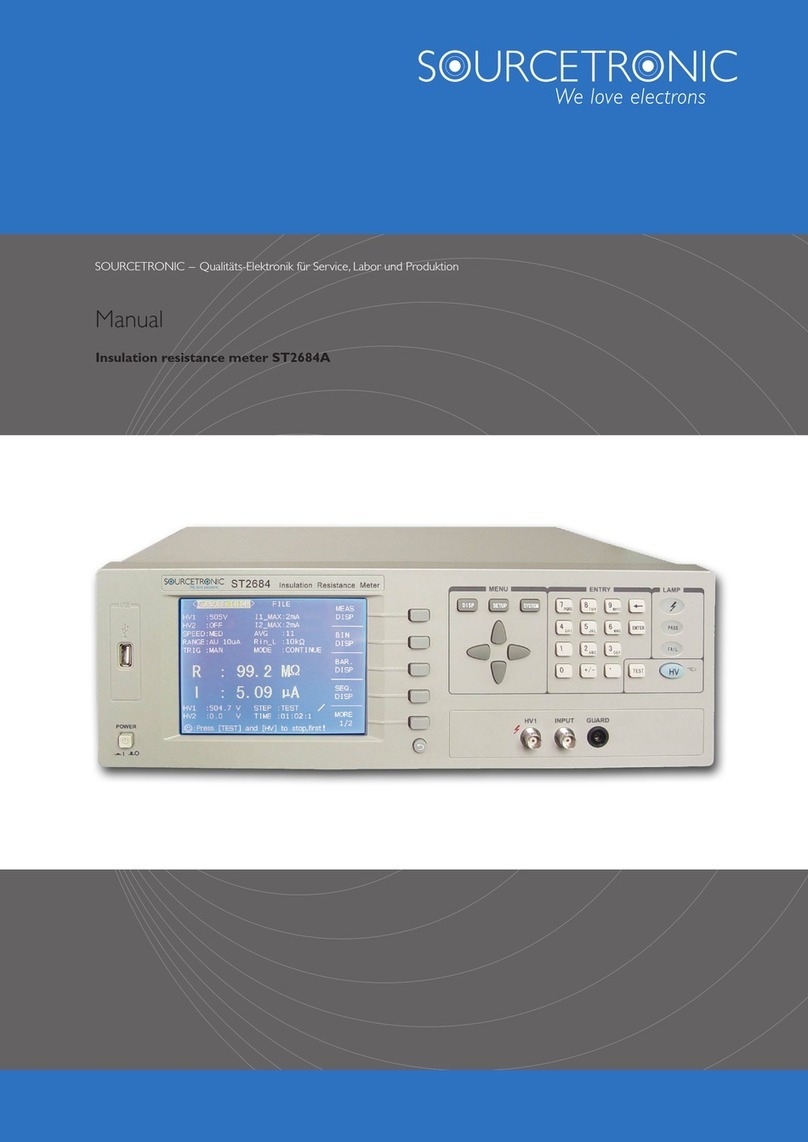
Sourcetronic
Sourcetronic ST2684A User manual

Sourcetronic
Sourcetronic TH2516 Series User manual
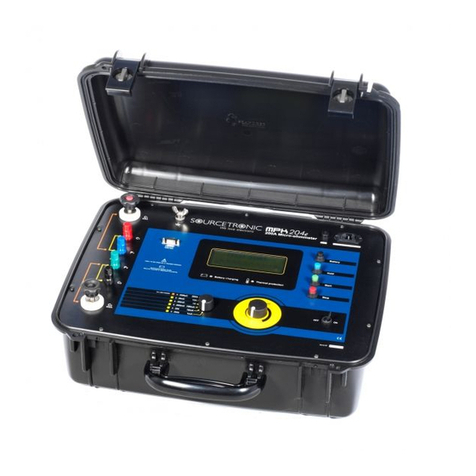
Sourcetronic
Sourcetronic MPK-204e User manual
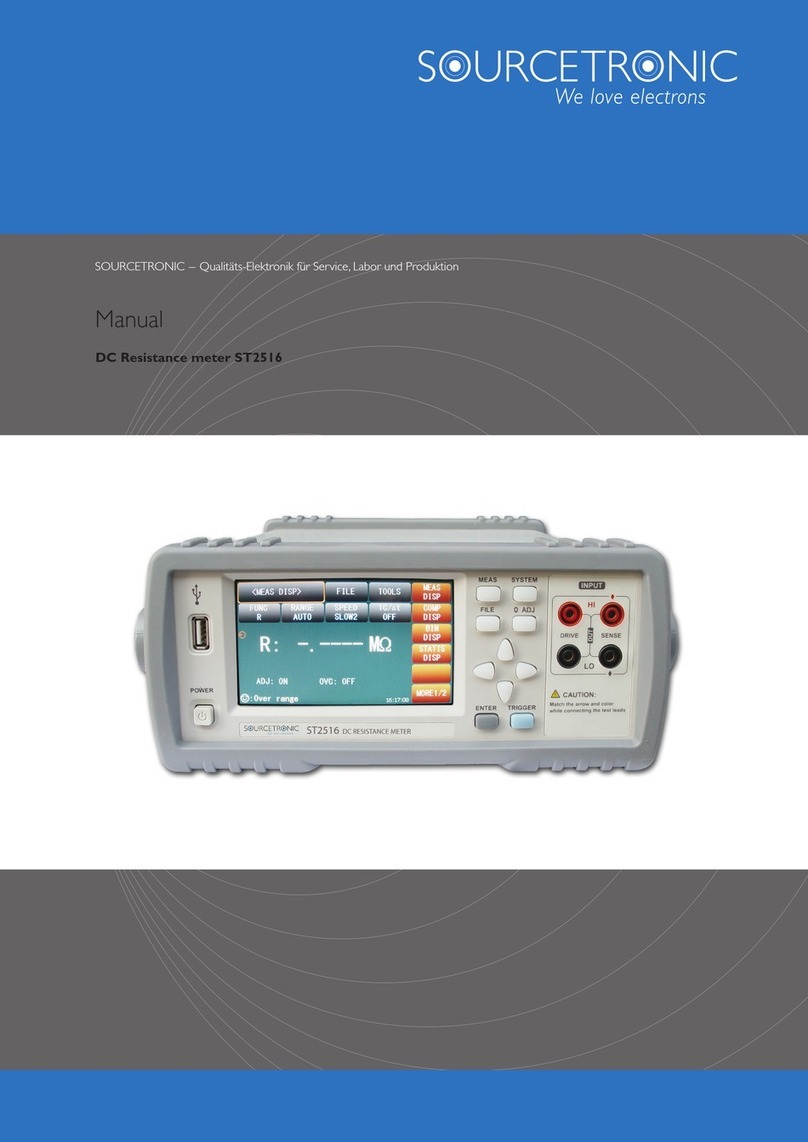
Sourcetronic
Sourcetronic ST2516 User manual
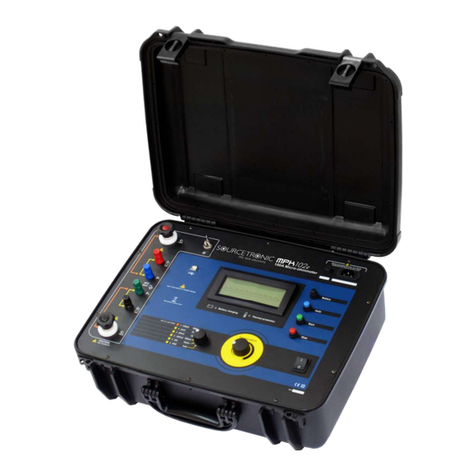
Sourcetronic
Sourcetronic MPK-102e User manual
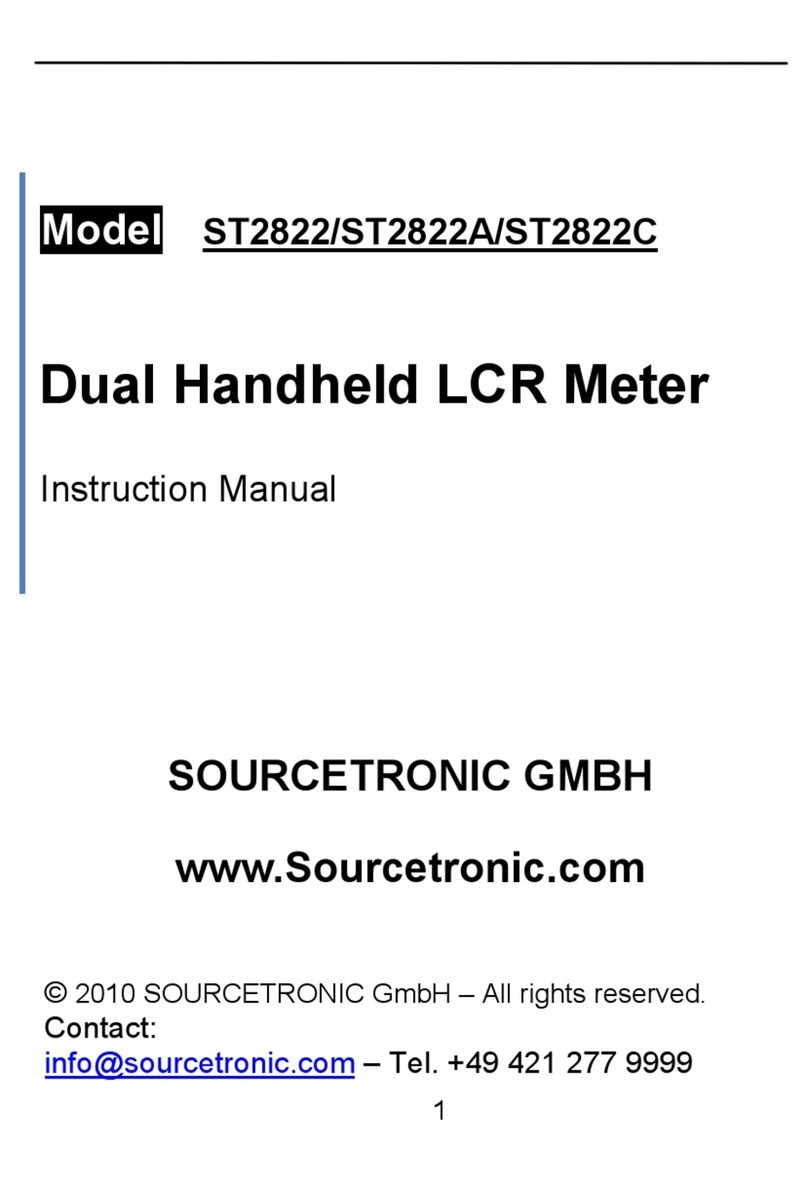
Sourcetronic
Sourcetronic ST2822 User manual
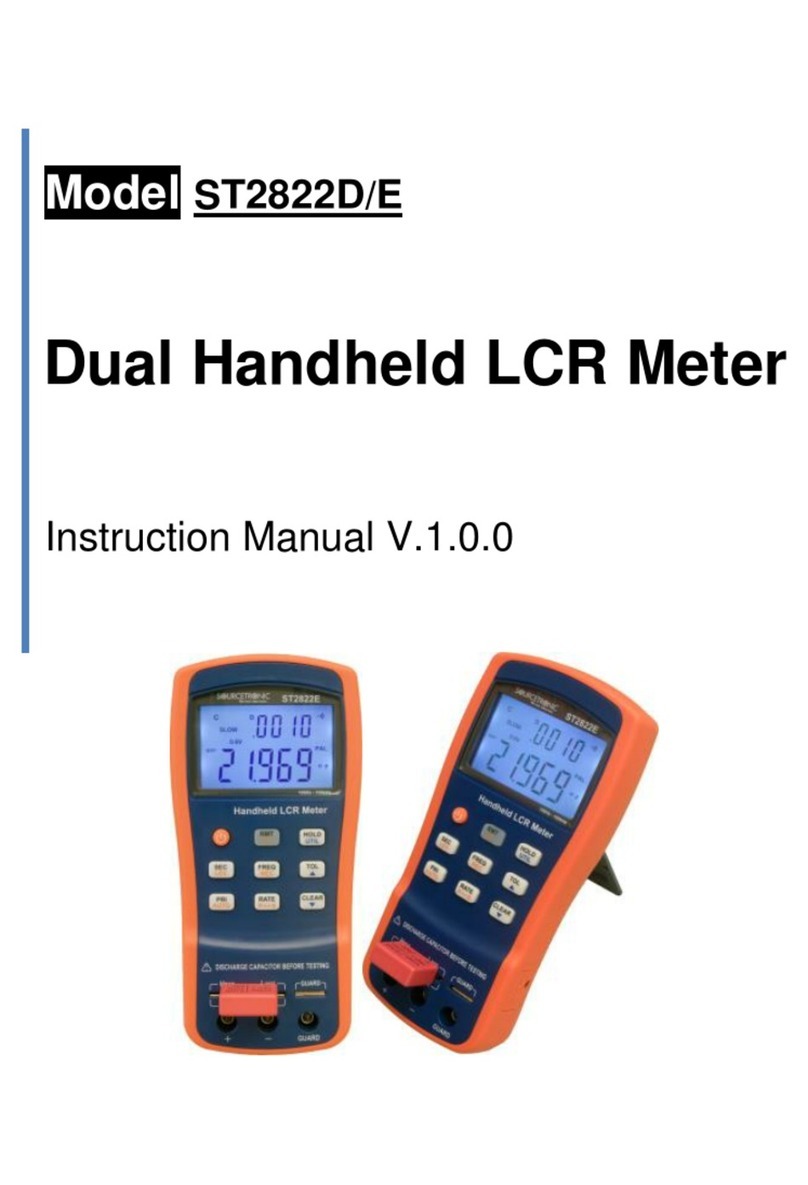
Sourcetronic
Sourcetronic ST2822D User manual
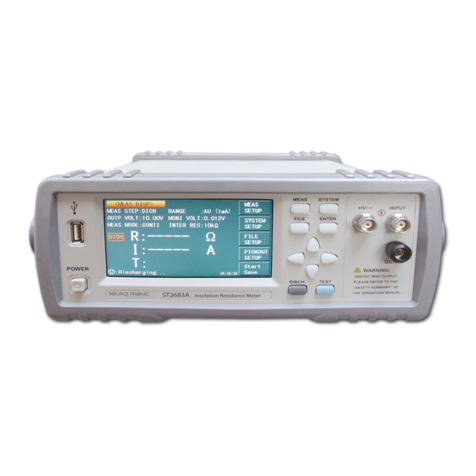
Sourcetronic
Sourcetronic ST2683A User manual
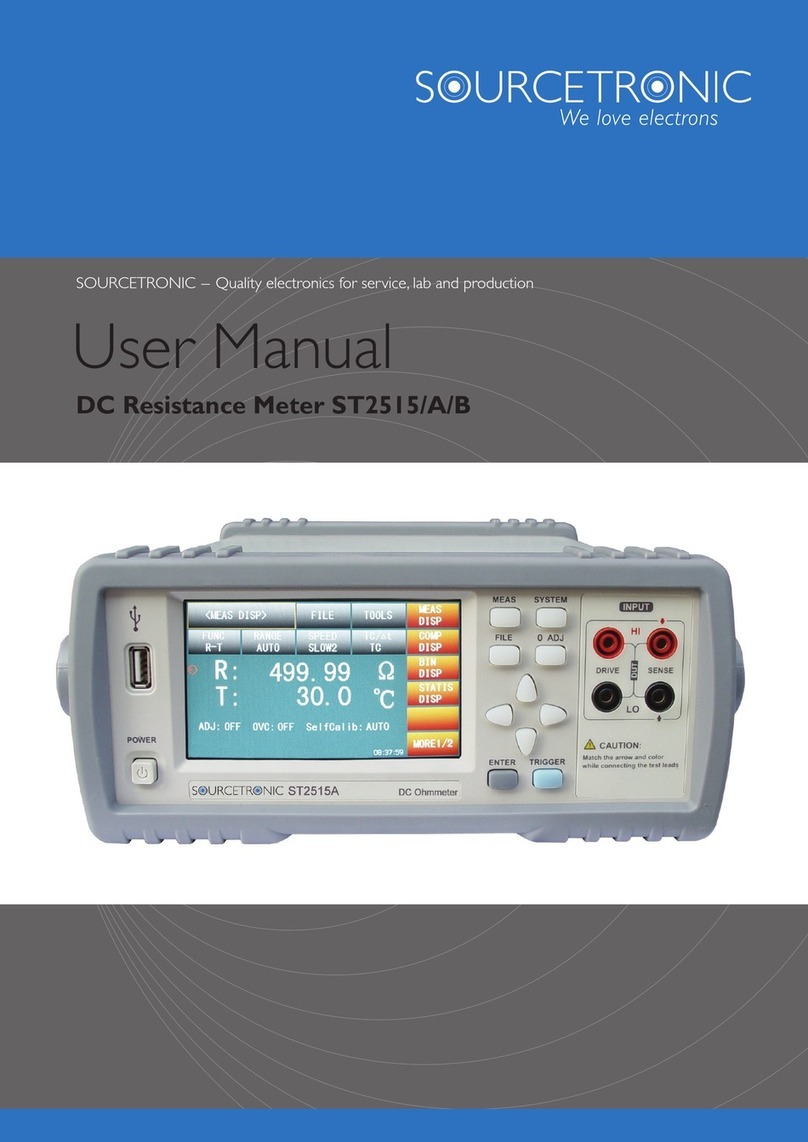
Sourcetronic
Sourcetronic ST2515 User manual
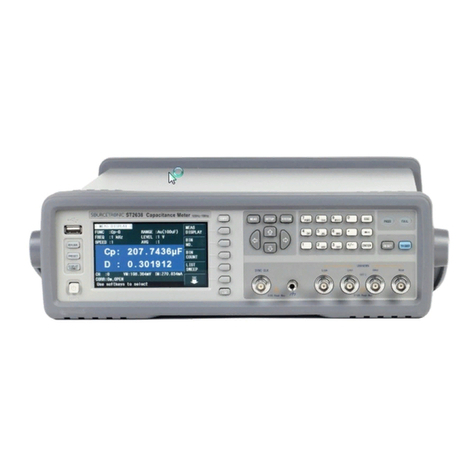
Sourcetronic
Sourcetronic ST2638 Series User manual
